Dragon fruit, scientifically known as Hylocereus spp., is a strikingly beautiful and exotic fruit that belongs to the cactus family. With its vibrant pink or yellow skin and speckled white or red flesh, dragon fruit has gained global popularity for its unique appearance, refreshing taste, and numerous health benefits. Rich in antioxidants, vitamin C, fiber, and essential minerals, dragon fruit is not only a nutritious addition to the diet but also a profitable fruit for home gardeners and commercial growers alike.
Container gardening has emerged as an effective method for growing dragon fruit, especially for urban dwellers, balcony gardeners, or regions with limited space. This guide provides a complete, step-by-step approach to growing dragon fruit in containers, covering selection, planting, care, and harvesting practices.
Why Grow Dragon Fruit in Containers?
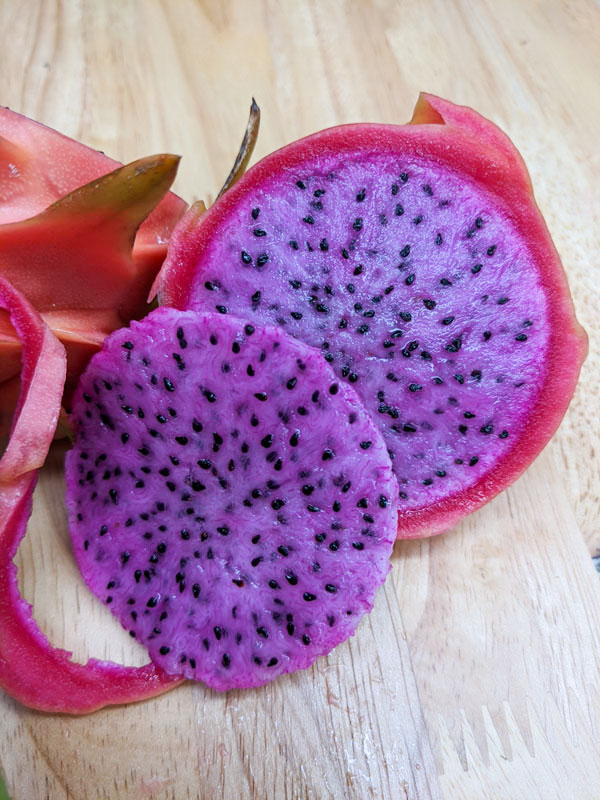
Container gardening offers several advantages:
- Space Efficiency: Ideal for apartments, patios, or small yards.
- Mobility: Containers can be moved to optimize sunlight exposure or protect plants from adverse weather.
- Soil Control: Allows precise management of soil composition and drainage.
- Pest Management: Easier monitoring and control of pests and diseases.
- Aesthetic Appeal: Dragon fruit cacti have a climbing, ornamental growth habit, adding beauty to balconies and gardens.
Choosing the Right Dragon Fruit Variety
Dragon fruit varieties vary in skin color, flesh color, and taste. For container cultivation, consider compact and manageable varieties:
- Hylocereus undatus (White Flesh): Most common; pink skin with white flesh. Sweet and mild flavor.
- Hylocereus costaricensis (Red Flesh): Pink skin with deep red flesh; sweeter and richer in antioxidants.
- Hylocereus megalanthus (Yellow Dragon Fruit): Yellow skin with white flesh; very sweet and high in vitamin C.
Compact varieties with shorter stems are easier to manage in containers, while climbing varieties may require trellises or supports.
Selecting the Right Container
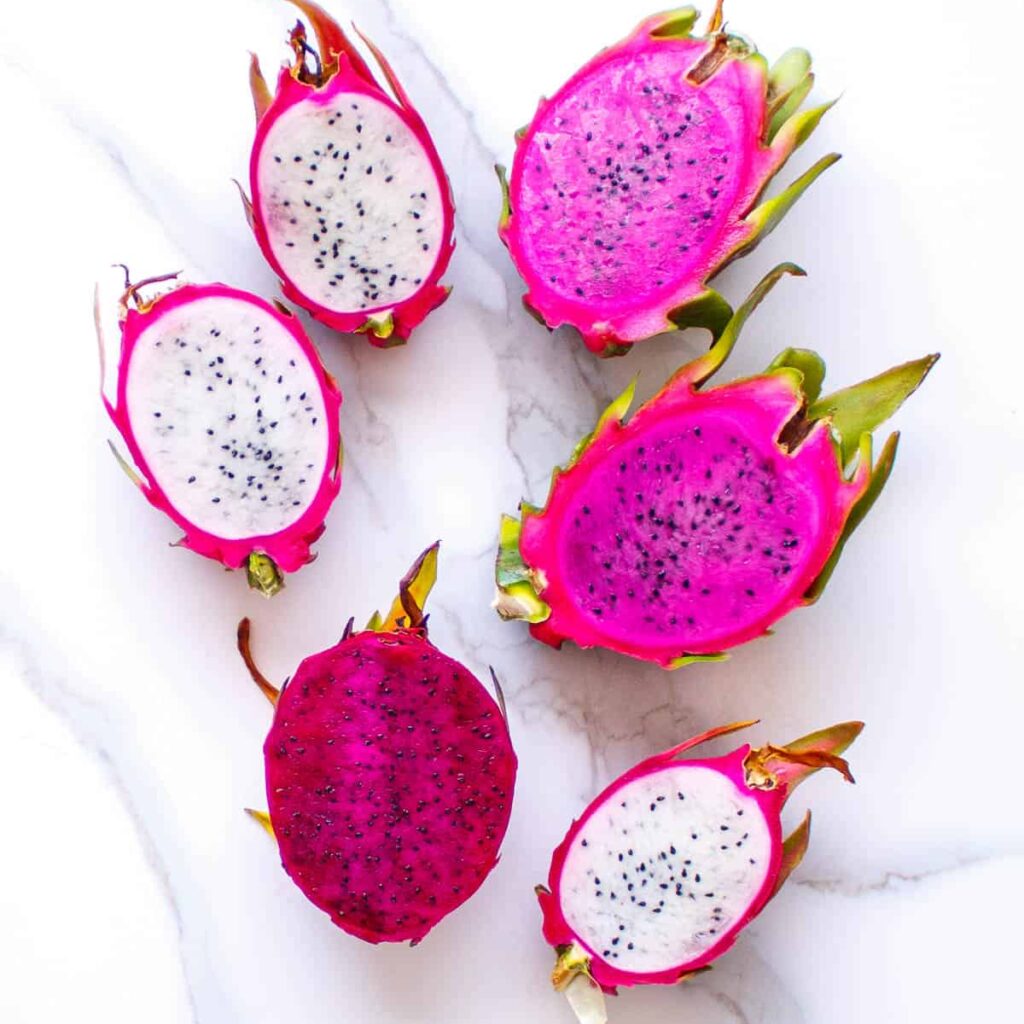
The choice of container is critical for dragon fruit growth:
- Material: Terracotta, plastic, or ceramic pots work well. Terracotta allows better aeration, while plastic retains moisture.
- Size: Minimum 18–24 inches in diameter and depth for young plants. Mature dragon fruit may require larger containers (24–30 inches).
- Drainage: Ensure adequate drainage holes to prevent waterlogging, which can cause root rot.
- Support: Use stakes, trellises, or cages to support vertical growth.
Soil Requirements
Dragon fruit thrives in well-draining soil with moderate fertility:
- Composition: Mix equal parts of cactus soil, sandy loam, and organic compost.
- pH Range: Slightly acidic to neutral (6.0–7.0).
- Nutrient Management: Add slow-release fertilizers rich in potassium and phosphorus for flowering and fruiting.
Avoid heavy clay soils or water-retentive media, as these can harm the roots.
Planting Dragon Fruit in Containers
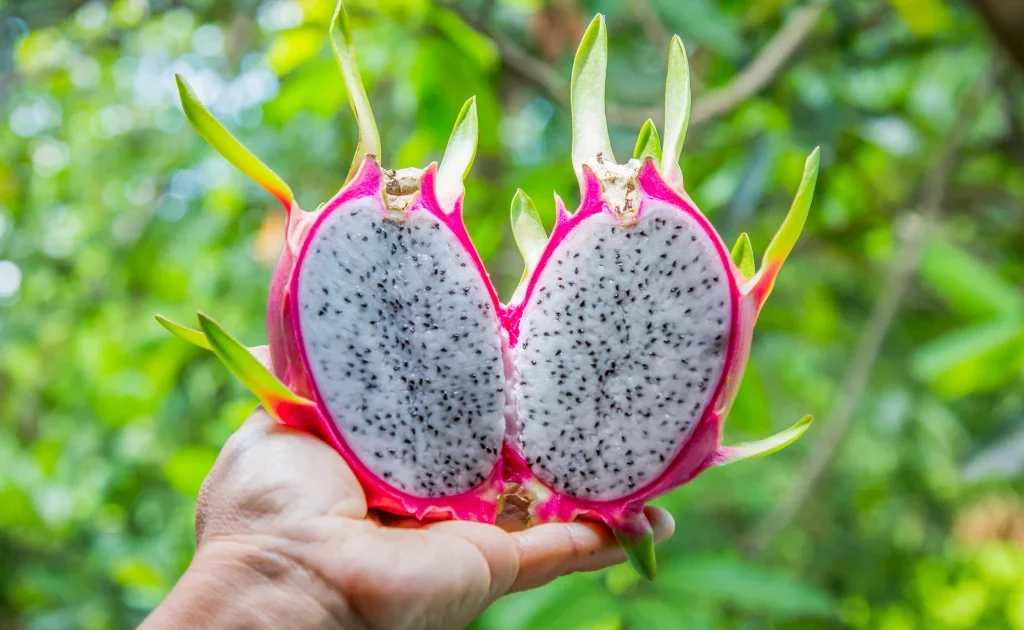
Step-by-Step Process:
- Prepare the Container: Ensure it is clean and has adequate drainage holes.
- Add Soil: Fill the container with well-draining soil mixture.
- Planting Cuttings or Seedlings:
- Use 12–18 inch cuttings or healthy seedlings.
- Bury the cutting 2–3 inches into the soil.
- Support with a stake or trellis for climbing varieties.
- Watering: Water lightly after planting to settle the soil. Avoid waterlogging.
- Positioning: Place the container in a sunny location with at least 6–8 hours of direct sunlight daily.
Watering Practices
Dragon fruit is a succulent cactus and has moderate water requirements:
- Frequency: Water every 2–3 days during the growing season, reducing to once a week in winter.
- Method: Deep watering to reach the roots; avoid wetting the stem excessively.
- Signs of Overwatering: Yellowing stems, root rot, and fungal infections.
- Signs of Underwatering: Wrinkled stems and slow growth.
Fertilization
Balanced nutrition is essential for vigorous growth and fruiting:
- Nitrogen (N): Promotes vegetative growth.
- Phosphorus (P): Encourages flowering and root development.
- Potassium (K): Supports fruit development and overall plant health.
Fertilization Schedule:
- Use a balanced fertilizer (10:10:10 or 15:15:15) every 6–8 weeks during the growth season.
- Supplement with organic compost or worm castings for nutrient-rich soil.
Pruning and Training
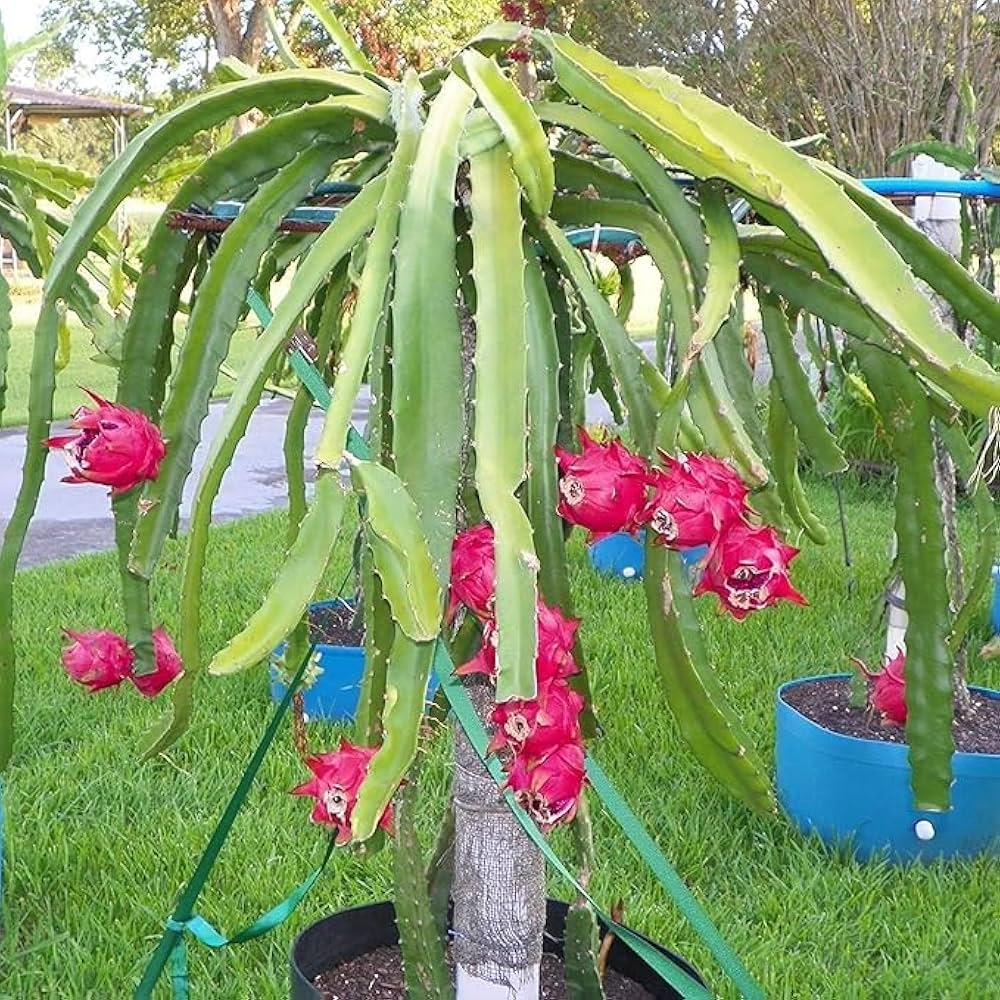
Pruning helps maintain plant health, shape, and fruit production:
- Remove damaged, diseased, or weak stems.
- Trim overcrowded branches to allow sunlight penetration and airflow.
- Train climbing stems along a trellis or stake to encourage vertical growth.
- Maintain a manageable height for container growth, typically 3–4 feet.
Pollination and Flowering
Dragon fruit flowers are nocturnal and often require pollination for fruit set:
- Self-Pollinating Varieties: Some types can set fruit without cross-pollination.
- Hand Pollination: For higher yield, gently transfer pollen from stamens to stigma using a small brush.
- Flowering Season: Typically blooms in summer; flowers last 1–2 nights.
- Indicators of Fruit Set: Swelling at the base of flowers after successful pollination.
Pest and Disease Management
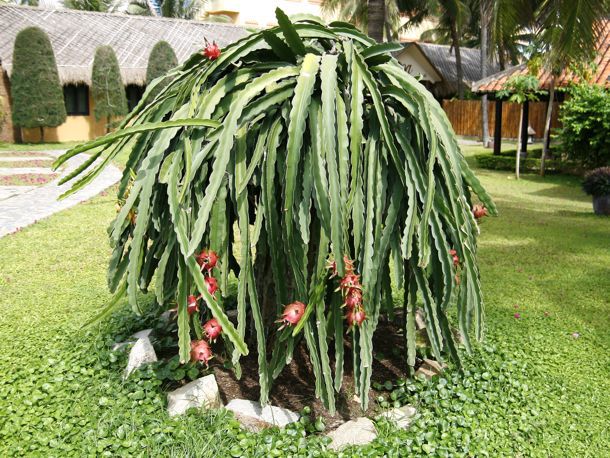
Dragon fruit is relatively hardy but can be affected by pests and diseases:
Common Pests:
- Mealybugs: Remove by hand or use insecticidal soap.
- Aphids: Spray with neem oil or insecticidal soap.
- Spider Mites: Maintain humidity and clean leaves regularly.
Common Diseases:
- Root Rot: Caused by overwatering; ensure well-draining soil.
- Stem Rot and Leaf Spot: Remove affected parts; apply fungicides if necessary.
- Sunburn: Provide partial shade during intense heat.
Harvesting Dragon Fruit
Dragon fruit is ready to harvest 30–50 days after flowering depending on variety and climate:
- Indicators of Ripeness:
- Skin color changes (pink, red, or yellow) depending on variety.
- Slight softening when gently pressed.
- Harvesting Technique:
- Use a sharp knife or scissors to cut the fruit, leaving a small stem attached.
- Avoid bruising the fruit to extend shelf life.
- Post-Harvest Storage:
- Store at 8–10°C for up to 2 weeks.
- Room temperature storage is suitable for 3–5 days for immediate consumption.
Tips for Successful Container Cultivation
- Sunlight: Ensure 6–8 hours of direct sunlight daily. Rotate containers periodically.
- Temperature: Maintain 20–35°C for optimal growth; protect from frost.
- Container Size: Upgrade to larger containers as plants grow to accommodate root expansion.
- Support Structures: Trellises or cages prevent sprawling and support fruit-bearing stems.
- Regular Monitoring: Check for pests, nutrient deficiencies, and growth progress regularly.
Benefits of Growing Dragon Fruit in Containers
- Health Benefits: Fresh dragon fruit is rich in fiber, antioxidants, and vitamins.
- Aesthetic Value: Adds exotic beauty to balconies, patios, and gardens.
- Sustainability: Reduces dependency on commercially sourced fruits.
- Profit Potential: High market demand allows small-scale growers to earn income.
Conclusion
Growing dragon fruit in containers is a rewarding and manageable way to cultivate this exotic fruit at home or in urban settings. With proper container selection, soil preparation, watering, fertilization, pruning, and pest management, gardeners can enjoy fresh, nutrient-rich dragon fruit year after year.
By choosing compact varieties, ensuring optimal sunlight and drainage, and providing support for climbing stems, even small spaces can yield abundant harvests. Container cultivation not only brings the nutritional and economic benefits of dragon fruit closer to urban gardeners but also enhances the aesthetic appeal of home gardens, terraces, and patios.
With careful attention to plant care, flowering, and harvesting practices, dragon fruit in containers can thrive, providing a combination of exotic beauty, delicious fruit, and health benefits that make it a valuable addition to any garden or home-growing project.
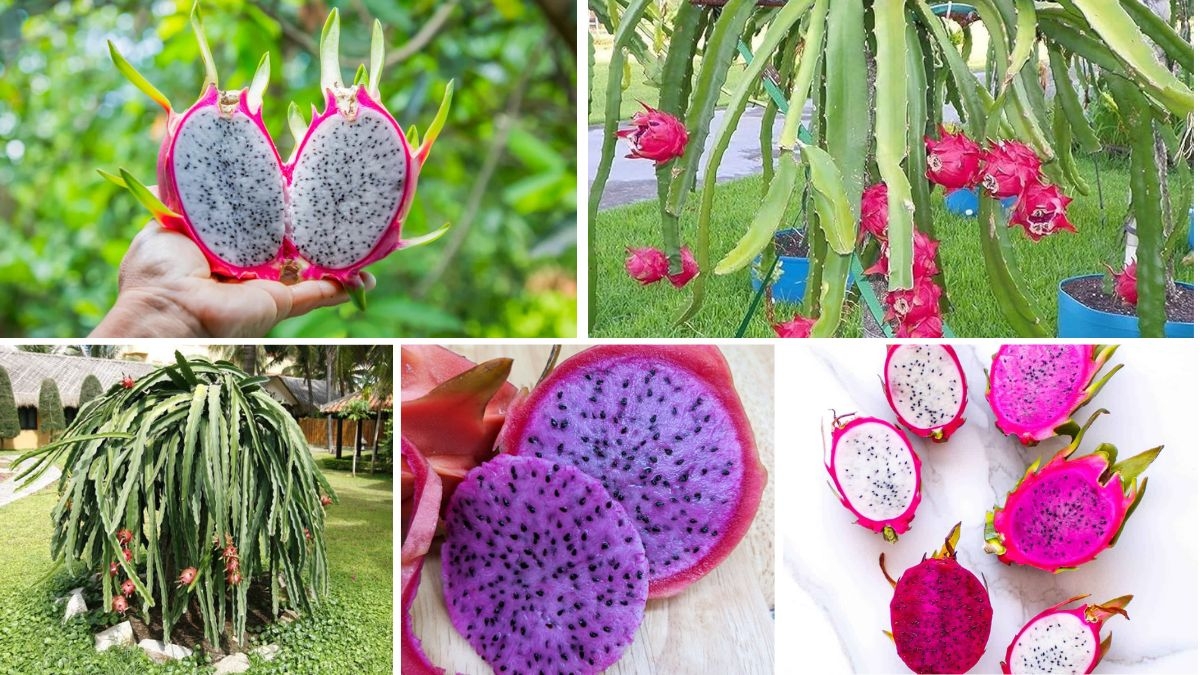
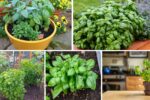




Leave A Comment